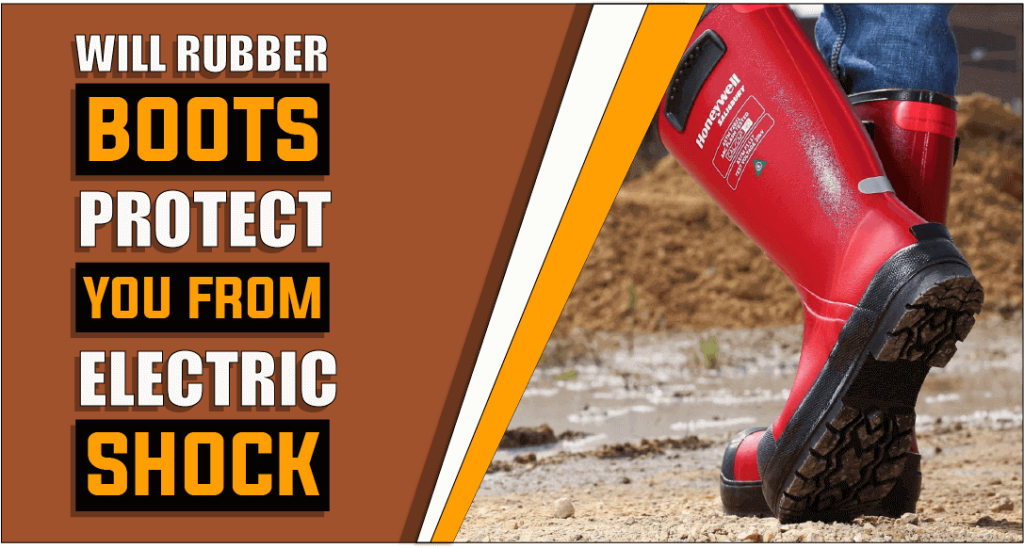Will Rubber Boots Protect You From Electric Shock – Know Before You Wear
Are you concerned about the risks posed by electricity in your working environment? Are you looking for an effective way to protect yourself from electric shock and potential injury? Have you ever found yourself in a situation where you’re standing in an area of electrical danger such as working directly on an appliance while plugged into the wall or needing to check out a power line during heavy rain? If so, then it’s important to know whether or not your footwear can protect you from electric shock. Rubber boots are well-known for their waterproof abilities, but will they also help protect against electricity? Today we’re taking a look at exactly what rubber boots have to offer and if they will rubber boots protect you from electric shock. Read on to learn more about why rubber boots are your best bet against electric shocks – and stay safe while using electricity!

Let’s explore Will Rubber Boots Protect You From Electric Shock
Rubber boots are designed to protect the wearer from wet and slippery surfaces, but do they protect against electric shocks? This is an important question as many people work in hazardous environments where there is a risk of coming into contact with electrically charged objects. The answer depends on several factors, including the type of rubber boots being worn and the voltage of the electric shock.
Rubber boots are usually made of rubber or plastic and provide some insulation against electricity. However, they are not designed to protect the wearer from high-voltage electric shocks. The amount of insulation provided by rubber boots will depend on their material, thickness, and any additional protective coating that may have been applied. In many cases, rubber boots can provide some protection from low-voltage electric shocks, such as those that may come from household electrical outlets.
It is important to note that even if the rubber boots are providing some insulation against electricity, this is not a guarantee of complete protection. The wearer needs to exercise caution when working around electrically charged objects and take all necessary safety precautions. It is recommended to wear protective clothing such as insulated gloves and coveralls to provide additional protection from electric shocks.
In conclusion, rubber boots can provide some level of insulation against electricity, however, they should not be relied upon to protect the wearer from high-voltage electric shocks. Protective clothing should always be worn in hazardous environments to provide the greatest level of protection.
The history of rubber boots for Protection From Electric Shock?
The use of rubber boots for protection from electric shock dates back to the early 19th century. In 1837, Charles Goodyear patented his vulcanized rubber boots and introduced them to the market. Goodyear’s invention was a major milestone in providing safety against electric shocks. For the first time, people were able to wear protective footwear that was insulated from electric currents. The rubber boots provided not only protection from electric shock but also a great amount of insulation and comfort that could never be achieved with leather or cloth footwear at the time.
In the early 1900s, rubber boots became an essential piece of protective equipment for workers in hazardous electrical environments such as power plants and mining operations. The rubber boots were able to provide increased safety and protection from electric shock in these hazardous environments.
In the 1950s, technological advancements led to improved insulation materials that were used to manufacture rubber boots. This made them even more effective in protecting the worker against electric shocks. These new improvements also provided better comfort while providing superior grip, insulation, and protection.
Today, rubber boots are still widely used in electrical industries as well as in a variety of industrial and recreational settings. They provide essential protection against electric shock while also providing comfort and durability. Modern rubber boots come with safety ratings that indicate the level of electrical protection they can offer. The higher the rating, the more protection they provide.
Rubber boots are an essential piece of protective equipment for anyone who works in hazardous electrical environments and provides the necessary level of safety and comfort that can help to reduce the risk of electric shock. It is important to select rubber boots with the appropriate safety rating to ensure maximum protection while at work.
Different types of rubber boots for Protection From Electric Shock?
Rubber boots are an essential piece of protective equipment for workers who come in contact with electricity or other sources of electric shock. Rubber boots provide a barrier between the worker’s feet and the electrical circuit, and can help protect against shocks resulting from accidental contact with energized parts.
There are several types of rubber boots available on the market designed to protect workers from electric shock. Let’s take a look at the different types and their features.
1: Insulating Rubber Boots:
These rubber boots are designed to protect from direct contact with live electrical circuits or energized parts up to 1000 volts. They are made of an outer layer of natural rubber that provides insulation against electric shock, with a flexible midsole for comfort and an inner lining for insulation and comfort.
2: Anti-Static Rubber Boots:
These boots are designed to protect from static electricity build-up, making them a good choice for workers in electrical situations where the risk of electric shock is low. The soles of anti-static rubber boots are made from special materials that dissipate static charge to reduce its build-up.
3: ESD (Electrostatic Discharge) Rubber Boots:
These boots are designed to provide protection from static electricity as well as provide resistance against electrostatic discharge (ESD). They are made with an outer layer of natural rubber combined with a midsole that dissipates static electricity, and an inner lining for insulation and comfort. The soles of ESD rubber boots are designed to reduce the risk of electric shock from static electricity build-up.
4: Arc Flash Rubber Boots:
These boots are designed to protect from arc flashes, which are intense and sudden bursts of energy that occur when an electric current passes through air or other material. The rubber boots have an outer layer of natural rubber designed to protect against arc flash, as well as a flexible midsole and inner lining for insulation and comfort.
So, when it comes to safety in the workplace, rubber boots are an essential piece of protective equipment. Make sure you choose the right type of boot for your job and environment so that you have maximum protection against electric shock.
How to choose the right pair of rubber boots to Protect You From Electric Shock?
When working in damp conditions, the risk of electric shock can be a serious and potentially deadly hazard. To help protect yourself from potential electric shocks, rubber boots are the best form of protective apparel you can wear. Rubber boots protect by acting as an insulator that blocks electricity from reaching your body. Choosing the right pair of rubber boots to protect you from electric shock is not as simple as it may seem. Here are some things to consider when making your selection:
1: Look for boots that are made of rubber material.
Rubber is the best choice for protecting against electric shocks. Be sure to check the label or contact the manufacturer to be sure your rubber boots are made from genuine rubber and not synthetic materials. Tests have shown that synthetic materials are not as effective in protecting against electric shocks.
2: Check for any exposed metal parts on the boot.
Metal components, such as buckles, hooks, or zippers, can conduct electricity and cause electric shock. It’s best to select boots with no metal parts or rubber-covered metal parts. This will help to ensure that you are completely insulated from electricity.
3: Opt for waterproof boots if you are working in wet conditions.
Waterproofing your boots helps prevent water from entering the boot and coming into contact with your skin. Rubber boots that are insulated and rated for electrical protection will provide the most comprehensive protection from electric shock.
4: Choose shoes that fit properly and are comfortable to wear.
Wearing uncomfortable boots can cause you to trip or slip, both of which increase the risk of electric shock. Make sure your boots fit snugly and are not too tight or too loose. If possible, try them on before purchasing.
5: Select boots with good tread and slip-resistant soles.
Shoes with textured, non-slip outsoles will provide a better grip on wet or slippery surfaces and help to prevent slips and falls.
6: Make sure the boots meet ASTM safety standards. The
ASTM (American Society for Testing and Materials) is a third-party organization that sets standards for protective apparel and footwear. Look for boots with an ASTM label or contact the manufacturer to ensure your rubber boots are compliant with their safety requirements.
7: Check the insulation rating of your boots.
The insulation rating of rubber boots tells you how much electric current they can protect you from. Look for boots that have a high insulation rating, as this will give you greater protection in wet conditions. Insulation ratings are typically expressed in volts, with higher numbers indicating greater insulation.
By following these tips, you can make an informed decision when selecting the right pair of rubber boots to protect you from electric shock. With the right pair of boots, you can work confidently in any environment knowing that your safety is protected.
Relevant Questions:
The answer depends on several factors, including the voltage and amount of electricity involved, as well as the type of rubber used. Natural rubber does provide insulation from low-voltage electrical current, although it is not suitable for use in high-voltage applications. Synthetic rubbers such as neoprene, silicone, and EPDM are better suited for those types of situations. Additionally, the thickness of the rubber, as well as its temperature rating, must be considered before it can be used safely. In some cases, multiple layers may be necessary to provide adequate protection. It is always important to remember that electricity can be dangerous and in many cases should only be handled by a qualified professional.
It is possible to walk in electrified water with rubber boots, but it’s not advisable due to the potential danger of electrocution. Rubber boots offer some insulation, but they cannot guarantee your safety if you are walking through water that contains electricity. If you must walk in electrified water, make sure to wear protective gear such as insulated rubber boots, insulated gloves, and a safety harness. It’s also important to be aware of your surroundings and make sure that you avoid any contact with exposed electrical wires or other sources of electricity while walking in electrified water. Moreover, seek expert advice before attempting to do so as the risks involved can be severe.
To avoid electric shock, it is important to wear shoes with rubber soles, avoid wearing any jewelry or metal objects that could conduct electricity, and make sure your clothing is dry. Additionally, it is best to avoid standing in water while working with electrical equipment. Use insulated tools when working on electrical components and never attempt to work on an energized circuit. Finally, be sure to wear insulated gloves when working on energized equipment. Following these safety precautions will help protect you from the risk of electric shock.
Electricians wear rubber shoes to protect themselves from electric shock. Rubber is an excellent insulator and reduces the risk of being electrocuted while working with electricity. By wearing rubber-soled shoes, electricians also reduce the chances of creating a spark that could cause a fire or explosion due to static electricity. Electricians should always ensure they have proper protective gear, including rubber-soled shoes when working with electricity. This helps them stay safe while they carry out their job.
Conclusion Paragraph
In conclusion, the answer to the question “Will Rubber Boots Protect You From Electric Shock?” is that it depends on the situation. If you are standing in wet rubber boots on a dry floor, they will not protect you from electric shock. However, if you are standing in wet rubber boots on a wet floor, they will protect you from electric shock. So, the next time you’re wondering whether or not rubber boots will protect you from electric shock, remember to consider the circumstances.
Ella John created BootsSolution.com with the vision of helping people to find the perfect boots for any occasion. As an expert in the field of footwear, she has created a comprehensive guide to finding the perfect boots. With her BA (Hons) in Footwear Design from De Montfort University, UK, Ella John has been writing about boots for several years. On BootsSolution.com you can find helpful information about the latest trends, tips for taking care of your boots, and advice on how to choose the right pair. Ella’s mission is to provide her readers with the best possible advice and help make sure that everyone can look their best in a perfect pair of boots. So if you’re looking for the information and inspiration you need to find the perfect boots, look no further than BootsSolution.com.






